Like
@bamban I swim in the XTC pool for a while now and the experience with MIL/LEO and XTC all combines to say just a few things here.
1) Typical XTC loads are hotter (higher pressure) than folks think. They are very hard on brass to say the least. Ejector marks are common and normal. The primer flow he is showing is not. Expect to scrap short line brass after 4 cycles, when normal pressure give something on the order of 14 cycles.
2) Even Varget can be edgy at the top, and all it takes is a hot day or fouled barrel to tip it over. Don't play at the very top till you have more experience, (if ever in hot weather, you really don't need to anyway).
3) The barrel and extension the OP was given was from a known problematic batch, I would say it isn't worth the trouble. Go get that upper re-barreled by WOA and sleep easy. If you are getting serious with XTC, you should consider owning two uppers anyway.
4) The known typical velocities of the 77 and 80 class bullets in these SR rigs is not a mystery, and when the value goes too high or too low, we stop and investigate with known good reference ammo (Black Hills, or an expert's hand loads to be specific) and a chronograph. If a barrel causes too many issues, we huck it. Life is too short to waste much time on bad barrels, and those come along every year. Yes, the borescope inspection should not show a fouled barrel or do not pass go. Scrub it to clean and then re-test.
5) At any XTC club with well attended matches, hand that gun, brass, and notes to one of the mentors and you will get an honest debug in short order.
6) Run an AR friendly primer like a REM 7.5 or Fed MAR, not a common small rifle one.
This AR pattern knowledge base in the XTC game has gone on since the early 90s. It only took about two seasons to see the lines adopt the black guns and the wooden ones disappeared quickly.
That happened for two reasons, the performance was equal or better, but the operating cost and reliability were not even close.
Thus, the experience base we have for the AR-15/M16 in this respect is long and deep. We can't debug this over the internet, but it would take a short visit at the club or base to pass or reject this rig/ammo.
 Help Support Long Range Hunting Forum
Help Support Long Range Hunting Forum


